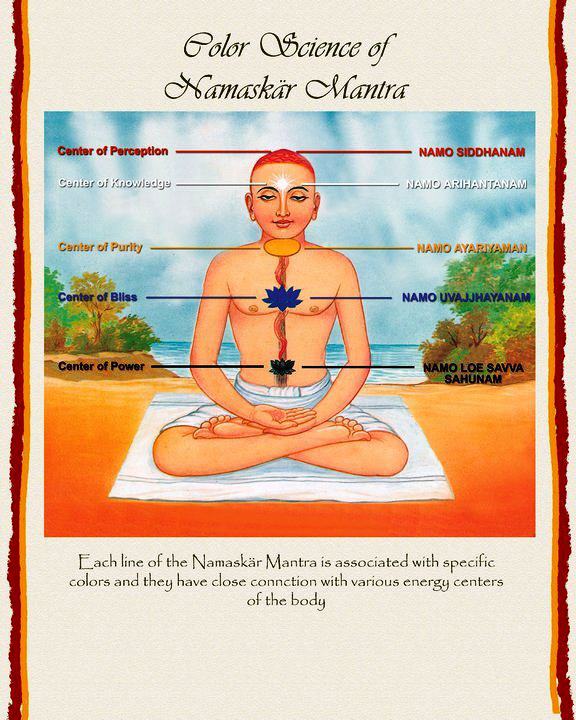Namaskāra Mantra
Sanskrit: homage formula
namo arihantāṇaṁ
namo siddhāṇaṁ
namo āyariyāṇaṁ
namo uvajjhāyāṇaṁ
namo loe savvasāhūṇaṁ.
eso panca namokkaro
savva-pava-panasano
maṅgalāṇaṁ ca savvesiṁ
paḍhamaṁ havai maṅgalaṁA daily prayer always recited in the original Prākrit, it pays homage to the supreme beings or five types of holy being:
- arhat - enlightened teacher
- siddha - liberated soul
- ācārya - mendicant leader
- upādhyāya - preceptor or teacher
- sādhu - mendicant
Note that chanting the mantra is not praying for something, material or otherwise. Also known as the Pañca-namaskāra-mantra or 'Fivefold Homage mantra', it is also called the Navakāra-mantra or Navkār-mantra in modern Indian languages.
The Namokar Mantra is the most fundamental mantra in Jainism and can be recited at any time of the day. While reciting the Namokar Mantra, the aspirant bows with respect to Arihantas, Siddhas, Acharyas, Upadhyayas, Sadhus, and Sadhvis. The mantra enables us to worship the virtues of all the supreme spiritual people instead of just worshipping one particular person. For this reason, the Namokar Mantra does not mention the names of any Tirthankaras, Siddhas, Acharyas, Upadhyayas, Sadhus, or Sadhvis. At the time of recitation, we remember their virtues and try to emulate them. In this mantra we bow down to these supreme spiritual personalities, and therefore, it is also called Namaskar or Namokar Mantra.
The Navkar Mantra contains the essence of Jainism. It points out that if we want to be truly liberated, we have to give up worldly life (samsar). The first stage of renunciation is to become a monk (sadhu) or nun (sadhvi). While progressing on a spiritual path, some may be designated as Upadhyayas or Acharya. The ultimate aim is to attain omniscience, becoming an Arihanta, which leads us to liberation, the becoming a Siddha.
The Mantra:
Namo Arihantanam
Namo Siddhanam
Namo Ayriyanam
Namo Uvajjhayanam
Namo Loe Savva-sahunam
Eso Panch Namokaro
Savva-pavappanasano
Manglananch Savvesim
Padhamam Havei Mangalam
[Avasyaka sutra 1.2]
The Namokar Mantra meaning in English:
| Namo Arihantanam | I bow down to Arihanta, |
| Namo Siddhanam | I bow down to Siddha, |
| Namo Ayriyanam | I bow down to Acharya, |
| Namo Uvajjhayanam | I bow down to Upadhyaya, |
| Namo Loe Savva-sahunam | I bow down to Sadhu and Sadhvi. |
| Eso Panch Namokaro | These five bowing downs, |
| Savva-pavappanasano | Destroy all the sins, |
| Manglananch Savvesim | Amongst all that is auspicious, |
| Padhamam Havei Mangalam | This Namokar Mantra is the foremost. |
- Namokar Mantra and Science of Colour:
